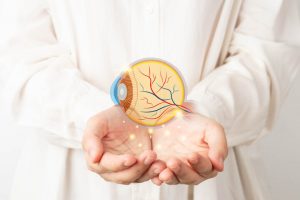A new study by researchers at Wilmer Eye Institute, Johns Hopkins Medicine not only explains why some patients with wet age-related macular degeneration (or “wet” AMD) do not see vision improvement with treatment, but also how an experimental drug might be used with existing treatments for wet AMD to preserve vision.
Lack of Vision Improvement in Wet Macular Degeneration
Wet AMD, one of two types of AMD, is a progressive eye disease caused by the excessive growth of blood vessels in the retina, the light-sensitive tissue in the eye that also transmits visual signals to the brain. Such blood vessels – caused by an overexpression of a protein called VEGF, which leads to the growth of blood vessels – then leak fluid or bleed and damage the retina, leading to vision loss. Despite the severe vision loss often experienced by people with wet AMD, fewer than half of patients treated with monthly intravitreal injections, known as anti-VEGF therapies, show substantial improvement in their vision. Furthermore, most of those who do benefit from improved vision lose those gains over time.
In the full report, published in Proceedings of the National Academy of Sciences, the research team led by Wilmer now reports how such anti-VEGF therapies may actually contribute to a lack of vision improvement by triggering the overexpression of a second protein. Known as ANGPTL4, this protein is similar to VEGF in that it can also stimulate the overproduction of abnormal blood vessels in the retina. “We have previously reported that ANGPTL4 was elevated in patients who did not respond well to anti-VEGF treatment,” says Akrit Sodhi, M.D., Ph.D., corresponding author and associate professor of ophthalmology and the Branna and Irving Sisenwein Professor of Ophthalmology at Johns Hopkins University School of Medicine and Wilmer Eye Institute. “In this work, we were able to observe a paradoxical increase in ANGPTL4 in patients receiving anti-VEGF injections – anti-VEGF therapy itself activated the expression of this protein.”
The team compared VEGF and ANGPTL4 levels in the ocular fluid of 52 patients with wet AMD at different stages of anti-VEGF treatment. Prior to anti-VEGF injections, wet AMD patients had high levels of ANGPTL4 and VEGF proteins. After treatment, their VEGF levels decreased as expected, but ANGPTL4 levels continued to rise, suggesting that ANGPTL4 remained active after anti-VEGF injections and that the treatments contributed to an increase in ANGPTL4. Such ANGPTL4 activity can lead to excessive blood vessel spread and no vision improvement. The team then explored ways to bridge the gap for patients with elevated ANGPTL4 levels after anti-VEGF treatments by testing the experimental drug 32-134D in mice with wet AMD. The drug lowers levels of a third protein, HIF-1, which is known to be involved in wet AMD and diabetic eye disease by stimulating VEGF production. The researchers hypothesized that the HIF inhibitor 32-134D would have a similar effect on ANGPTL4 after anti-VEGF treatment because ANGPTL4 production is also activated by HIF-1.
Optimizing Anti-VEGF Therapy for All Patients
In mice treated with 32-134D, the team observed a decrease in HIF-1 and VEGF levels, as well as a decrease in ANGPTL4 levels and blood vessel overgrowth. Mice treated with anti-VEGF therapies alone confirmed the team’s results in human patients: VEGF levels were lower, but ANGPTL4 levels increased, preventing anti-VEGF therapies from completely preventing blood vessel growth (and vision loss). The researchers also found that combining 32-134D with anti-VEGF treatments prevented the increase in HIF-1, VEGF, and ANGPTL4. This combination of treatments was more effective than either drug alone and shows promise for the treatment of wet AMD.
According to the researchers, this work shows a way to improve anti-VEGF therapy for all patients and potentially help a subset of patients with wet AMD who, despite treatment, still lose vision over time. The researchers hope that this [project] will advance the three goals they have in relation to wet AMD: making current therapies as effective as possible, identifying new therapies, and preventing people from developing wet AMD in the first place.






